| 登録情報 | データベース: PDB / ID: 3ckh
|
|---|
| タイトル | Crystal structure of Eph A4 receptor |
|---|
 要素 要素 | Ephrin type-A receptor 4 |
|---|
 キーワード キーワード | TRANSFERASE / Eph receptor / ATP-binding / Glycoprotein / Kinase / Membrane / Nucleotide-binding / Phosphoprotein / Transmembrane / Tyrosine-protein kinase |
|---|
| 機能・相同性 |  機能・相同性情報 機能・相同性情報
DH domain binding / neuron projection fasciculation / : / negative regulation of proteolysis involved in protein catabolic process / corticospinal tract morphogenesis / regulation of astrocyte differentiation / neuron projection guidance / nephric duct morphogenesis / fasciculation of sensory neuron axon / fasciculation of motor neuron axon ...DH domain binding / neuron projection fasciculation / : / negative regulation of proteolysis involved in protein catabolic process / corticospinal tract morphogenesis / regulation of astrocyte differentiation / neuron projection guidance / nephric duct morphogenesis / fasciculation of sensory neuron axon / fasciculation of motor neuron axon / synapse pruning / negative regulation of cellular response to hypoxia / negative regulation of axon regeneration / transmembrane-ephrin receptor activity / glial cell migration / positive regulation of amyloid precursor protein catabolic process / PH domain binding / regulation of modification of synaptic structure / GPI-linked ephrin receptor activity / regulation of synapse pruning / adherens junction organization / positive regulation of dendrite morphogenesis / regulation of dendritic spine morphogenesis / negative regulation of cell adhesion / motor neuron axon guidance / EPH-Ephrin signaling / innervation / adult walking behavior / regulation of GTPase activity / negative regulation of epithelial to mesenchymal transition / Somitogenesis / regulation of axonogenesis / positive regulation of amyloid-beta formation / EPHA-mediated growth cone collapse / positive regulation of intracellular signal transduction / negative regulation of long-term synaptic potentiation / cochlea development / EPH-ephrin mediated repulsion of cells / ephrin receptor signaling pathway / axonal growth cone / ephrin receptor binding / axon terminus / positive regulation of cell adhesion / axon guidance / protein tyrosine kinase binding / peptidyl-tyrosine phosphorylation / negative regulation of cell migration / dendritic shaft / filopodium / adherens junction / positive regulation of JNK cascade / neuromuscular junction / receptor protein-tyrosine kinase / postsynaptic density membrane / negative regulation of ERK1 and ERK2 cascade / Schaffer collateral - CA1 synapse / cellular response to amyloid-beta / kinase activity / negative regulation of neuron projection development / amyloid-beta binding / protein autophosphorylation / presynaptic membrane / protein tyrosine kinase activity / early endosome membrane / perikaryon / dendritic spine / negative regulation of neuron apoptotic process / mitochondrial outer membrane / protein kinase activity / cell adhesion / negative regulation of translation / protein stabilization / positive regulation of cell migration / axon / positive regulation of cell population proliferation / dendrite / glutamatergic synapse / cell surface / ATP binding / identical protein binding / plasma membrane / cytoplasm類似検索 - 分子機能 Ephrin type-A receptor 4, SAM domain / Ephrin type-A receptor 4, ligand binding domain / Tyrosine-protein kinase ephrin type A/B receptor-like / Tyrosine-protein kinase ephrin type A/B receptor-like / Ephrin receptor type-A /type-B / Ephrin receptor ligand binding domain / Tyrosine-protein kinase, receptor class V, conserved site / Ephrin receptor, transmembrane domain / : / Ephrin receptor ligand binding domain ...Ephrin type-A receptor 4, SAM domain / Ephrin type-A receptor 4, ligand binding domain / Tyrosine-protein kinase ephrin type A/B receptor-like / Tyrosine-protein kinase ephrin type A/B receptor-like / Ephrin receptor type-A /type-B / Ephrin receptor ligand binding domain / Tyrosine-protein kinase, receptor class V, conserved site / Ephrin receptor, transmembrane domain / : / Ephrin receptor ligand binding domain / Ephrin type-A receptor 2 transmembrane domain / Receptor tyrosine kinase class V signature 1. / Receptor tyrosine kinase class V signature 2. / Eph receptor ligand-binding domain profile. / Ephrin receptor ligand binding domain / Putative ephrin-receptor like / SAM domain (Sterile alpha motif) / Galactose-binding domain-like / SAM domain profile. / Sterile alpha motif. / Sterile alpha motif domain / Sterile alpha motif/pointed domain superfamily / Fibronectin type III domain / Fibronectin type 3 domain / Fibronectin type-III domain profile. / Galactose-binding-like domain superfamily / Fibronectin type III / Fibronectin type III superfamily / Tyrosine-protein kinase, catalytic domain / Tyrosine kinase, catalytic domain / Tyrosine protein kinases specific active-site signature. / Tyrosine-protein kinase, active site / Serine-threonine/tyrosine-protein kinase, catalytic domain / Protein tyrosine and serine/threonine kinase / Jelly Rolls / Serine/Threonine protein kinases, catalytic domain / Protein kinase, ATP binding site / Protein kinases ATP-binding region signature. / Immunoglobulin-like fold / Protein kinase domain profile. / Protein kinase domain / Protein kinase-like domain superfamily / Sandwich / Mainly Beta類似検索 - ドメイン・相同性 |
|---|
| 生物種 |  Homo sapiens (ヒト) Homo sapiens (ヒト) |
|---|
| 手法 |  X線回折 / X線回折 /  分子置換 / 解像度: 2.8 Å 分子置換 / 解像度: 2.8 Å |
|---|
 データ登録者 データ登録者 | Shi, J.H. / Song, J.X. |
|---|
 引用 引用 |  ジャーナル: J.Biol.Chem. / 年: 2008 ジャーナル: J.Biol.Chem. / 年: 2008
タイトル: Crystal Structure and NMR Binding Reveal That Two Small Molecule Antagonists Target the High Affinity Ephrin-binding Channel of the EphA4 Receptor.
著者: Qin, H. / Shi, J. / Noberini, R. / Pasquale, E.B. / Song, J. |
|---|
| 履歴 | | 登録 | 2008年3月15日 | 登録サイト: RCSB / 処理サイト: PDBJ |
|---|
| 改定 1.0 | 2008年9月23日 | Provider: repository / タイプ: Initial release |
|---|
| 改定 1.1 | 2011年7月13日 | Group: Version format compliance |
|---|
| 改定 1.2 | 2021年11月10日 | Group: Database references / カテゴリ: database_2 / struct_ref_seq_dif
Item: _database_2.pdbx_DOI / _database_2.pdbx_database_accession / _struct_ref_seq_dif.details |
|---|
| 改定 1.3 | 2022年4月13日 | Group: Database references / カテゴリ: citation / Item: _citation.title |
|---|
| 改定 1.4 | 2023年11月1日 | Group: Data collection / Refinement description
カテゴリ: chem_comp_atom / chem_comp_bond / pdbx_initial_refinement_model |
|---|
| 改定 1.5 | 2024年11月20日 | Group: Structure summary
カテゴリ: pdbx_entry_details / pdbx_modification_feature |
|---|
|
|---|
 データを開く
データを開く 基本情報
基本情報 要素
要素 キーワード
キーワード 機能・相同性情報
機能・相同性情報 Homo sapiens (ヒト)
Homo sapiens (ヒト) X線回折 /
X線回折 /  分子置換 / 解像度: 2.8 Å
分子置換 / 解像度: 2.8 Å  データ登録者
データ登録者 引用
引用 ジャーナル: J.Biol.Chem. / 年: 2008
ジャーナル: J.Biol.Chem. / 年: 2008 構造の表示
構造の表示 Molmil
Molmil Jmol/JSmol
Jmol/JSmol ダウンロードとリンク
ダウンロードとリンク ダウンロード
ダウンロード 3ckh.cif.gz
3ckh.cif.gz PDBx/mmCIF形式
PDBx/mmCIF形式 pdb3ckh.ent.gz
pdb3ckh.ent.gz PDB形式
PDB形式 3ckh.json.gz
3ckh.json.gz PDBx/mmJSON形式
PDBx/mmJSON形式 その他のダウンロード
その他のダウンロード 3ckh_validation.pdf.gz
3ckh_validation.pdf.gz wwPDB検証レポート
wwPDB検証レポート 3ckh_full_validation.pdf.gz
3ckh_full_validation.pdf.gz 3ckh_validation.xml.gz
3ckh_validation.xml.gz 3ckh_validation.cif.gz
3ckh_validation.cif.gz https://data.pdbj.org/pub/pdb/validation_reports/ck/3ckh
https://data.pdbj.org/pub/pdb/validation_reports/ck/3ckh ftp://data.pdbj.org/pub/pdb/validation_reports/ck/3ckh
ftp://data.pdbj.org/pub/pdb/validation_reports/ck/3ckh リンク
リンク 集合体
集合体

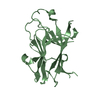

 要素
要素 Homo sapiens (ヒト) / 遺伝子: EPHA4, HEK8, SEK, TYRO1 / プラスミド: pET32A / 発現宿主:
Homo sapiens (ヒト) / 遺伝子: EPHA4, HEK8, SEK, TYRO1 / プラスミド: pET32A / 発現宿主: 
 X線回折 / 使用した結晶の数: 1
X線回折 / 使用した結晶の数: 1  試料調製
試料調製 回転陽極 / タイプ: RIGAKU / 波長: 1.5418 Å
回転陽極 / タイプ: RIGAKU / 波長: 1.5418 Å 分子置換
分子置換 解析
解析 分子置換
分子置換 ムービー
ムービー コントローラー
コントローラー







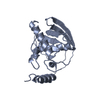

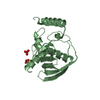

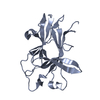

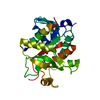
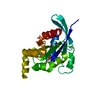
 PDBj
PDBj







